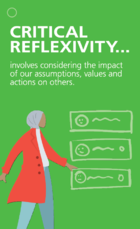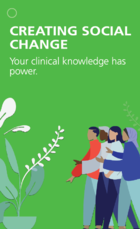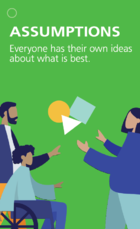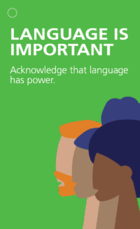Human Dimensions of Illness Experience: Difference between revisions
Kim Jackson (talk | contribs) No edit summary |
(Updated categories) |
||
| (12 intermediate revisions by 3 users not shown) | |||
| Line 1: | Line 1: | ||
<div class="editorbox"> '''Original Editor '''- [[User:Rewan Elsayed Elkanafany|Rewan Elsayed Elkanafany]] and [[User:Kim Jackson|Kim Jackson]] '''Top Contributors''' - {{Special:Contributors/{{FULLPAGENAME}}}}</div> | <div class="editorbox"> '''Original Editor '''- [[User:Rewan Elsayed Elkanafany|Rewan Elsayed Elkanafany]] and [[User:Kim Jackson|Kim Jackson]] '''Top Contributors''' - {{Special:Contributors/{{FULLPAGENAME}}}}</div> | ||
== Introduction == | == Introduction == | ||
In order to enhance the lives of the people they work with, it is essential health professionals consider the | In order to enhance the lives of the people they work with, it is essential for health professionals to consider the "human" dimensions of illness and (dis)ability. This is perhaps particularly the case when people are consulting healthcare providers for support with chronic and/or progressive conditions. "Human" dimensions include the emotional<ref>Setchell, J., Abrams, T., McAdam, L., & Gibson, B. E. (2019). Cheer* in healthcare practice: What it excludes and why it matters. ''Qualitative health research, 29''(13), 1890-1903. doi:10.1177/1049732319838235</ref>, phenomenological<ref>Abrams, T., & Setchell, J. (2018). Living with death in rehabilitation: A phenomenological account. ''Human Studies, 41''(4), 677-695. </ref>, social, existential, and moral<ref>Abrams, T., Setchell, J., Thille, P., Mistry, B., & Gibson, B. E. (2018). Affect, intensity, and moral assemblage in rehabilitation practice. ''Biosocieties, Online first''. [https://doi.org/10.1057/s41292-018-0115-2 doi:https://doi.org/10.1057/s41292-018-0115-2]</ref> dimensions of illness experiences, which combine and interact with the physical/biological dimensions. These aspects of the illness experiences can include factors such as dealing with disability stigma<ref>Setchell, J. (2017). What has stigma got to do with physiotherapy? ''Physiotherapy Canada, 69''(1), 1-4. </ref>, creating meaningful shortened lives, living well with reduced physical function and managing family interactions.<ref name=":0">Setchell, J., Thille, P., Abrams, T., McAdam, L., Mistry, B., & Gibson, B. E. (2018). Enhancing the human aspects of care with young people with Muscular Dystrophy: Results from a participatory qualitative study with clinicians. ''Child: Health, Care and Development, 44''(2), 269-277. doi:doi:10.1111/cch.12526 </ref> | ||
There may often be a discrepancy between the importance clinicians place on these human dimensions and what actually happens in the clinical setting<ref name=":0" />. Focusing on these aspects living with illness and (dis)ability can improve outcomes for both the person | There may often be a discrepancy between the importance clinicians place on these human dimensions and what actually happens in the clinical setting<ref name=":0" />. Focusing on these aspects of living with illness and (dis)ability, can improve outcomes for both the person experiencing illness/disability and the clinician. And of course, it is not just the understanding between the clinician and the client that is important, interactions within the multi-disciplinary team also have an impact on the level and quality of care. | ||
Below are some tips to help health professionals | Below are some tips to help health professionals reflect on the human dimensions of living with a chronic or progressive health condition. The tips are based on a set of cards called "Cards for Humanity" (available for printing - see below) which were an output from a 3-year project<ref>Setchell, J., Thille, P., Abrams, T., McAdam, L., Mistry, B., & Gibson, B. E. (2018). Enhancing the human aspects of care with young people with Muscular Dystrophy: Results from a participatory qualitative study with clinicians. ''Child: Health, Care and Development, 44''(2), 269-277. doi:doi:10.1111/cch.12526 </ref><ref>Setchell, J., McAdam, L., Abrams, T., Thille, P., Mistry, B., & Gibson, B. E. A realist evaluation of a project to enhance the human aspects of DMD care. ''Forthcoming''. </ref><ref>Thille, P., Gibson, B. E., Abrams, T., McAdam, L., Mistry, B., & Setchell, J. (2018). Enhancing the human dimensions of children's neuromuscular care: Piloting a methodology for fostering team reflexivity. ''Advances in Health Sciences Education, May 26''(1-23). </ref> investigating how clinicians did (or did not) attend to the human elements of living with muscular dystrophy. They were designed for clinicians working in children's neuromuscular outpatient settings, but have been useful in many settings including education and mentorship across various disciplines. We have also provided a poster which encourages physiotherapists to better attend to the human aspects of care (available for printing - see below). This comes from a separate but related project with adults with low back pain and physiotherapists. | ||
== Some Examples from the 'Cards for Humanity' == | == Some Examples from the 'Cards for Humanity' == | ||
=== Learning to Attend to the | === Learning to Attend to the "Human" Aspects : Up-skilling === | ||
[[File:CFH 13 Upskilling Front.png|frameless|229x229px|left]] | [[File:CFH 13 Upskilling Front.png|frameless|229x229px|left]] | ||
Clinicians can enhance the human aspects of client and family lives by improving understanding of: | Clinicians can enhance the human aspects of client and family lives by improving their understanding of: | ||
* Diversity and inclusion | * Diversity and inclusion; | ||
* Spirituality, meaning-making, religion | * Spirituality, meaning-making, religion; | ||
* Addressing and supporting 'negative' emotions | * Addressing and supporting 'negative' emotions; | ||
* Self-care for clinicians | * Self-care for clinicians; | ||
* Coping with client death and decline | * Coping with client death and decline; | ||
* Sexuality and disability | * Sexuality and disability. | ||
=== Critical Reflexivity === | === Critical Reflexivity === | ||
[[File:CFH 9 Critical Reflexivity Front.png|frameless|229x229px|left]] | [[File:CFH 9 Critical Reflexivity Front.png|frameless|229x229px|left]] | ||
"Critical reflexivity" (as understood within this context) refers to processes of examining the assumptions underlying clinical practice including “beliefs, values, social and systemic structures” and “how such dimensions influence our daily professional practice”<ref>Kinsella EA, Caty M, Ng S, Jenkins K. Reflective practice for allied health: Theory and applications. 2012. </ref>. There is an emphasis on considering the unintended assumptions and effects of any actions; including how power operates through individual health practices and broader systems of practice<ref>Setchell, J., & Dalziel, B. (2019). Using critical reflexivity to enhance clinical care: A clinician perspective. ''Journal of Humanities in Rehabilitation, May'', 1-12. </ref>. Critical reflexivity promotes change through challenging ingrained practices, roles and beliefs and values.<ref>Thille, P., Gibson, B. E., Abrams, T., McAdam, L., Mistry, B., & Setchell, J. (2018). Enhancing the human dimensions of children's neuromuscular care: Piloting a methodology for fostering team reflexivity. ''Advances in Health Sciences Education, May 26''(1-23). </ref><ref>Tremblay MC, Richard L, Brousselle A, Beaudet N. Learning reflexively from a health promotion professional development program in Canada. Health promotion international. 2014 Sep 1;29(3):538-48. | |||
</ref> | </ref> | ||
* Reflexivity often requires time, space and facilitation. | * Reflexivity often requires time, space and facilitation. | ||
| Line 29: | Line 29: | ||
=== Creating Social Change === | === Creating Social Change === | ||
[[File:CFH 11 Social Change Front.png|frameless|229x229px|left]]The burden of changing systems and structures | [[File:CFH 11 Social Change Front.png|frameless|229x229px|left]]The burden of changing systems and structures which disadvantage people with (dis)abilities, often falls on clients and/or families. As a clinician, your voice has power. | ||
Important areas for change include: | Important areas for change include: | ||
* Reducing disability stigma | * Reducing disability stigma; | ||
* Improved accessibility | * Improved accessibility; | ||
* Better service availability | * Better service availability. | ||
=== Difficult Topics === | === Difficult Topics === | ||
[[File:CFH 5 Difficult Topics Front.png|frameless|230x230px|left]]There are some topics | [[File:CFH 5 Difficult Topics Front.png|frameless|230x230px|left]]There are some topics which clinicians can find difficult to address, but are an important part of enhancing the client's illness experiences. "Difficult topics" can include discussions about: | ||
* Puberty, sex, sexuality, gender identity | * Puberty, sex, sexuality, gender identity; | ||
* Disability stigma, bullying, discrimination | * Disability stigma, bullying, discrimination; | ||
* Decline, death, dying | * Decline, death, dying; | ||
* Disease progression, the future | * Disease progression, the future. | ||
It is important that clinicians find ways to explore these | It is important that clinicians find ways to explore these "difficult topics" with clients in appropriate ways. Consider up-skilling in these areas if you think you would find them challenging. | ||
=== Assumptions === | === Assumptions === | ||
[[File:CFH 8 Assumptions Front.png|frameless|229x229px|left]] | [[File:CFH 8 Assumptions Front.png|frameless|229x229px|left]] | ||
Everyone has their own assumptions about what are the best ways to approach healthcare practice and living well with illness and (dis)ability. This can sometimes mean that we can unintentionally ignore the perspectives and preferences of clients and families. If clinicians are aware of their assumptions, they can work well with others to decide what is helpful. Assumptions: | Everyone has their own assumptions about what are the best ways to approach healthcare practice and living well with illness and (dis)ability. This can sometimes mean that we can unintentionally ignore the perspectives and preferences of clients and families. If clinicians are aware of their assumptions, they can work well with others to decide what is helpful. Assumptions: | ||
* Are reflected in the goals that clinicians think to be important or valuable (e.g. independence, activity, physical safety) | * Are reflected in the goals that clinicians think to be important or valuable (e.g. independence, activity, physical safety). | ||
* Might differ between/amongst clinicians and clients and families | * Might differ between/amongst clinicians and clients and families. | ||
* Assumptions can affect perceptions and impact care. | |||
Assumptions can affect perceptions and impact care. '''They can signal to clients what is expected, accepted | * '''They can signal to clients what is expected, accepted and considered 'normal'.''' | ||
Sometimes clinicians need to let go of their assumptions to provide good care! | Sometimes clinicians need to let go of their assumptions to provide good care! | ||
| Line 56: | Line 56: | ||
[[File:CFH 10 Language Front.png|left|frameless|229x229px]] | [[File:CFH 10 Language Front.png|left|frameless|229x229px]] | ||
Language has power and by acknowledging that you can improve the client’s experience and help to build a stronger connection. Misunderstandings, bias or feelings of not being heard can negatively impact a client and the interactions between clients and clinicians. Where possible: | Language has power and by acknowledging that you can improve the client’s experience and help to build a stronger connection. Misunderstandings, bias or feelings of not being heard can negatively impact a client and the interactions between clients and clinicians. Where possible: | ||
* Foster an awareness of the unintended effects of what you say | * Foster an awareness of the unintended effects of what you say. | ||
* Reduce the assumptions and biases underpinning what you say | * Reduce the assumptions and biases underpinning what you say. | ||
'''Words do matter!''' | |||
<br> | <br> | ||
== Resources == | == Resources == | ||
The Cards for Humanity are available for download and printing here: | The Cards for Humanity are available for download and printing here: | ||
'''NB: The cards are © 2019 Holland Bloorview Kids Rehabilitation Hospital. All rights reserved.''' | |||
* '''For printing on an office printer:''' [[:File:MD cards office printing.pdf|Cards for Humanity Office Printing - Download PDF]] | * '''For printing on an office printer:''' [[:File:MD cards office printing.pdf|Cards for Humanity Office Printing - Download PDF]] | ||
* '''For professional printing (indicate that you want them 'tarot card size' and laminated):''' [[:File:MD cards Professional Printers.pdf|Cards for Humanity Professional Printing - Download PDF]] | * '''For professional printing (indicate that you want them 'tarot card size' and laminated):''' [[:File:MD cards Professional Printers.pdf|Cards for Humanity Professional Printing - Download PDF]] | ||
The | The poster 'How Can Physios Enhance Lives' is available for download and printing here in various sizes: | ||
'''NB: Use professional printer and have it laminated, but also prints ok on office computers''' | |||
====English==== | |||
* '''A1:''' [[:File:How Can Physios Enhance Lives A1 01.pdf|How Can Physios Enhance Lives - Download PDF]] | |||
* '''A2:''' [[:File:How Can Physios Enhance Lives A2 01.pdf|How Can Physios Enhance Lives - Download PDF]] | |||
* '''A3:''' [[:File:How Can Physios Enhance Lives A3 01.pdf|How Can Physios Enhance Lives - Download PDF]] | |||
====Portuguese==== | |||
* '''A1:''' [[:File:Enhancing-care-poster-Portuguese A1.pdf|How Can Physios Enhance Lives (Portugese) - Download PDF]] | |||
* '''A2:''' [[:File:Enhancing-care-poster-Portuguese A2.pdf|How Can Physios Enhance Lives (Portugese) - Download PDF]] | |||
* '''A3:''' [[:File:Enhancing-care-poster-Portuguese A3.pdf|How Can Physios Enhance Lives (Portugese) - Download PDF]] | |||
====French==== | |||
* '''A1:''' [[:File:Enhancing-care-poster-French A1.pdf|How Can Physios Enhance Lives (French) - Download PDF]] | |||
* '''A2:''' [[:File:Enhancing-care-poster-French A2.pdf|How Can Physios Enhance Lives (French) - Download PDF]] | |||
* '''A3:''' [[:File:Enhancing-care-poster-French A3.pdf|How Can Physios Enhance Lives (French) - Download PDF]] | |||
== References == | == References == | ||
<references /> | <references /> | ||
[[Category:Communication]] | |||
[[Category:Projects]] | |||
Latest revision as of 09:13, 14 May 2021
Introduction[edit | edit source]
In order to enhance the lives of the people they work with, it is essential for health professionals to consider the "human" dimensions of illness and (dis)ability. This is perhaps particularly the case when people are consulting healthcare providers for support with chronic and/or progressive conditions. "Human" dimensions include the emotional[1], phenomenological[2], social, existential, and moral[3] dimensions of illness experiences, which combine and interact with the physical/biological dimensions. These aspects of the illness experiences can include factors such as dealing with disability stigma[4], creating meaningful shortened lives, living well with reduced physical function and managing family interactions.[5]
There may often be a discrepancy between the importance clinicians place on these human dimensions and what actually happens in the clinical setting[5]. Focusing on these aspects of living with illness and (dis)ability, can improve outcomes for both the person experiencing illness/disability and the clinician. And of course, it is not just the understanding between the clinician and the client that is important, interactions within the multi-disciplinary team also have an impact on the level and quality of care.
Below are some tips to help health professionals reflect on the human dimensions of living with a chronic or progressive health condition. The tips are based on a set of cards called "Cards for Humanity" (available for printing - see below) which were an output from a 3-year project[6][7][8] investigating how clinicians did (or did not) attend to the human elements of living with muscular dystrophy. They were designed for clinicians working in children's neuromuscular outpatient settings, but have been useful in many settings including education and mentorship across various disciplines. We have also provided a poster which encourages physiotherapists to better attend to the human aspects of care (available for printing - see below). This comes from a separate but related project with adults with low back pain and physiotherapists.
Some Examples from the 'Cards for Humanity'[edit | edit source]
Learning to Attend to the "Human" Aspects : Up-skilling[edit | edit source]
Clinicians can enhance the human aspects of client and family lives by improving their understanding of:
- Diversity and inclusion;
- Spirituality, meaning-making, religion;
- Addressing and supporting 'negative' emotions;
- Self-care for clinicians;
- Coping with client death and decline;
- Sexuality and disability.
Critical Reflexivity[edit | edit source]
"Critical reflexivity" (as understood within this context) refers to processes of examining the assumptions underlying clinical practice including “beliefs, values, social and systemic structures” and “how such dimensions influence our daily professional practice”[9]. There is an emphasis on considering the unintended assumptions and effects of any actions; including how power operates through individual health practices and broader systems of practice[10]. Critical reflexivity promotes change through challenging ingrained practices, roles and beliefs and values.[11][12]
- Reflexivity often requires time, space and facilitation.
- Clinicians need to create time to think about the human aspects of care.
- Both team and individual reflexivity are needed.
- Think about how clinical care can address the emotional, social and personal aspects of clients' lives.
Creating Social Change[edit | edit source]
The burden of changing systems and structures which disadvantage people with (dis)abilities, often falls on clients and/or families. As a clinician, your voice has power.
Important areas for change include:
- Reducing disability stigma;
- Improved accessibility;
- Better service availability.
Difficult Topics[edit | edit source]
There are some topics which clinicians can find difficult to address, but are an important part of enhancing the client's illness experiences. "Difficult topics" can include discussions about:
- Puberty, sex, sexuality, gender identity;
- Disability stigma, bullying, discrimination;
- Decline, death, dying;
- Disease progression, the future.
It is important that clinicians find ways to explore these "difficult topics" with clients in appropriate ways. Consider up-skilling in these areas if you think you would find them challenging.
Assumptions[edit | edit source]
Everyone has their own assumptions about what are the best ways to approach healthcare practice and living well with illness and (dis)ability. This can sometimes mean that we can unintentionally ignore the perspectives and preferences of clients and families. If clinicians are aware of their assumptions, they can work well with others to decide what is helpful. Assumptions:
- Are reflected in the goals that clinicians think to be important or valuable (e.g. independence, activity, physical safety).
- Might differ between/amongst clinicians and clients and families.
- Assumptions can affect perceptions and impact care.
- They can signal to clients what is expected, accepted and considered 'normal'.
Sometimes clinicians need to let go of their assumptions to provide good care!
Language is Important[edit | edit source]
Language has power and by acknowledging that you can improve the client’s experience and help to build a stronger connection. Misunderstandings, bias or feelings of not being heard can negatively impact a client and the interactions between clients and clinicians. Where possible:
- Foster an awareness of the unintended effects of what you say.
- Reduce the assumptions and biases underpinning what you say.
Words do matter!
Resources[edit | edit source]
The Cards for Humanity are available for download and printing here:
NB: The cards are © 2019 Holland Bloorview Kids Rehabilitation Hospital. All rights reserved.
- For printing on an office printer: Cards for Humanity Office Printing - Download PDF
- For professional printing (indicate that you want them 'tarot card size' and laminated): Cards for Humanity Professional Printing - Download PDF
The poster 'How Can Physios Enhance Lives' is available for download and printing here in various sizes:
NB: Use professional printer and have it laminated, but also prints ok on office computers
English[edit | edit source]
- A1: How Can Physios Enhance Lives - Download PDF
- A2: How Can Physios Enhance Lives - Download PDF
- A3: How Can Physios Enhance Lives - Download PDF
Portuguese[edit | edit source]
- A1: How Can Physios Enhance Lives (Portugese) - Download PDF
- A2: How Can Physios Enhance Lives (Portugese) - Download PDF
- A3: How Can Physios Enhance Lives (Portugese) - Download PDF
French[edit | edit source]
- A1: How Can Physios Enhance Lives (French) - Download PDF
- A2: How Can Physios Enhance Lives (French) - Download PDF
- A3: How Can Physios Enhance Lives (French) - Download PDF
References[edit | edit source]
- ↑ Setchell, J., Abrams, T., McAdam, L., & Gibson, B. E. (2019). Cheer* in healthcare practice: What it excludes and why it matters. Qualitative health research, 29(13), 1890-1903. doi:10.1177/1049732319838235
- ↑ Abrams, T., & Setchell, J. (2018). Living with death in rehabilitation: A phenomenological account. Human Studies, 41(4), 677-695.
- ↑ Abrams, T., Setchell, J., Thille, P., Mistry, B., & Gibson, B. E. (2018). Affect, intensity, and moral assemblage in rehabilitation practice. Biosocieties, Online first. doi:https://doi.org/10.1057/s41292-018-0115-2
- ↑ Setchell, J. (2017). What has stigma got to do with physiotherapy? Physiotherapy Canada, 69(1), 1-4.
- ↑ 5.0 5.1 Setchell, J., Thille, P., Abrams, T., McAdam, L., Mistry, B., & Gibson, B. E. (2018). Enhancing the human aspects of care with young people with Muscular Dystrophy: Results from a participatory qualitative study with clinicians. Child: Health, Care and Development, 44(2), 269-277. doi:doi:10.1111/cch.12526
- ↑ Setchell, J., Thille, P., Abrams, T., McAdam, L., Mistry, B., & Gibson, B. E. (2018). Enhancing the human aspects of care with young people with Muscular Dystrophy: Results from a participatory qualitative study with clinicians. Child: Health, Care and Development, 44(2), 269-277. doi:doi:10.1111/cch.12526
- ↑ Setchell, J., McAdam, L., Abrams, T., Thille, P., Mistry, B., & Gibson, B. E. A realist evaluation of a project to enhance the human aspects of DMD care. Forthcoming.
- ↑ Thille, P., Gibson, B. E., Abrams, T., McAdam, L., Mistry, B., & Setchell, J. (2018). Enhancing the human dimensions of children's neuromuscular care: Piloting a methodology for fostering team reflexivity. Advances in Health Sciences Education, May 26(1-23).
- ↑ Kinsella EA, Caty M, Ng S, Jenkins K. Reflective practice for allied health: Theory and applications. 2012.
- ↑ Setchell, J., & Dalziel, B. (2019). Using critical reflexivity to enhance clinical care: A clinician perspective. Journal of Humanities in Rehabilitation, May, 1-12.
- ↑ Thille, P., Gibson, B. E., Abrams, T., McAdam, L., Mistry, B., & Setchell, J. (2018). Enhancing the human dimensions of children's neuromuscular care: Piloting a methodology for fostering team reflexivity. Advances in Health Sciences Education, May 26(1-23).
- ↑ Tremblay MC, Richard L, Brousselle A, Beaudet N. Learning reflexively from a health promotion professional development program in Canada. Health promotion international. 2014 Sep 1;29(3):538-48.












